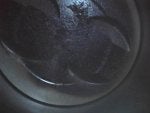I've got a 1993 GT 5-spd with ~133K miles. The motor is stock and original save for a CAI.
When I purchased it a few years ago it has 122K mi and wasn't consuming any more than about 0.5 qt of oil for the first 4-5K. The car was down on power though and had a semi-poor idle. Over the past couple years the relevant things I've done are:
When the motor is running right, it runs Really well (for a stock motor). It idles well, starts right up, is responsive, and makes good power. However, the motor has steadily been consuming more oil. I run 5W-30 high mileage and an FL-1A and it was consuming about 1QT every 4K and now it's up to about 1QT every 400mi. The only evidence of oil burning I see on the spark plugs is the #8 cylinder. It gets oil on the spark plug threads and the plug itself gets oil fouled and you can see evidence of oil on the piston crown. It originally seemed to be most noticeable on overrun/deceleration, but now I'm either running hog rich or burning some oil when I romp on it or pull away after idling for a couple of minutes. My mileage is down about 2mpg over where it had been (18 vs 20mpg).
When I pulled the rocker cover on the driver's side, there is no sludge and just (what I would consider) a normal amount of varnish given the age and mileage. There is oil sitting in the rocker arms as well as in a few low spots around the cylinder head.
My best guess is still worn out valve stem guides so I've proceeded with that. Any other ideas of what it could be? Am I missing something? I expected a noticeably higher leakage on the #8 cylinder. I didn't see any foreign material in the oil return galley next to #8 but I can't see down very far.
Also, what part number do you use for the valve stem seals? I originally got the Edelbrock 9758's because Amazon said they fit but they most certainly do not. They don't even match the measurements stated on the box. Best I can tell, the Fel-Pro SS72683 are the correct size and the proper Viton material. Any ideas here?
P.S. I do know that I need to do the fuel pump as it's getting quite whiney, but my fuel pressure numbers were fine when I tested them.
Update 2016-07-10
This past winter I completed the list of items below and then drove another 1000 mi this spring. Alas, I am still consuming oil at around a quart every 300-400mi and #8 is the only one showing evidence of oil in the cylinder. When replacing the valve stem seals, not a single valve rocked around in it's guide or felt "egged out". Is it possible for a single worn guide with fresh seals - one that isn't worn enough to feel egged out - to single handedly consume 1qt/300mi? It still seems most noticeable after decelerating with higher RPMs (i.e. high vacuum) or after idling for awhile. Once underway or repeated WOT acceleration doesn't give any bluish smoke or smell. My next guess is going to be to install a catch can. If that doesn't turn up the oil, then I'm out of ideas and I'm going to have to pull the heads next winter.
When I purchased it a few years ago it has 122K mi and wasn't consuming any more than about 0.5 qt of oil for the first 4-5K. The car was down on power though and had a semi-poor idle. Over the past couple years the relevant things I've done are:
- Plugs, wires, rotors & cap, ignition coil
- Seafoam through the intake & crankcase for ~200mi, short oil change intervals, fuel injector cleaner
- PCV valve/screen/hose
- Timing chain
- Front & Rear main seal
- All new vacuum-lines (silicone)
- 93 octane & timing @ 13 degrees,
- 70mm throttle body, IAC, TPS,
- O2 sensors, cleaned the MAF & EGR
- Base idle reset.
When the motor is running right, it runs Really well (for a stock motor). It idles well, starts right up, is responsive, and makes good power. However, the motor has steadily been consuming more oil. I run 5W-30 high mileage and an FL-1A and it was consuming about 1QT every 4K and now it's up to about 1QT every 400mi. The only evidence of oil burning I see on the spark plugs is the #8 cylinder. It gets oil on the spark plug threads and the plug itself gets oil fouled and you can see evidence of oil on the piston crown. It originally seemed to be most noticeable on overrun/deceleration, but now I'm either running hog rich or burning some oil when I romp on it or pull away after idling for a couple of minutes. My mileage is down about 2mpg over where it had been (18 vs 20mpg).
- I've done a vacuum test and that came back fine.
- I've checked the PCV valve and it rattles, the screen is clear, and I've replaced this entire assembly in the last 2 years.
- I've made sure there is a vacuum at the breather hose.
- Performed KOEO and KOER and pull no codes.
- I used a boroscope and you can see the cross-hatch honing marks in all the cylinders with 7 cylinders dry with minimal carbon build up and then #8 which has pronounced oil in the center of the piston with piston wash on the outer 1/4"-1/2". Compare #8 vs #7 (attached).
- I did a compression test with the motor at operating temperature and all 8 cylinders were between 158-162 PSI.
- I did a leak down test (with the motor totally cold unfortunately) and had between 9-13% on all 8, with most having 11% including #8. The majority of the air is leaking into the crankcase (coming out the dipstick and/or oil filler neck) but if you put your hand over the filler neck, you can hear some air coming out of the throttle body on #8.
When I pulled the rocker cover on the driver's side, there is no sludge and just (what I would consider) a normal amount of varnish given the age and mileage. There is oil sitting in the rocker arms as well as in a few low spots around the cylinder head.
My best guess is still worn out valve stem guides so I've proceeded with that. Any other ideas of what it could be? Am I missing something? I expected a noticeably higher leakage on the #8 cylinder. I didn't see any foreign material in the oil return galley next to #8 but I can't see down very far.
Also, what part number do you use for the valve stem seals? I originally got the Edelbrock 9758's because Amazon said they fit but they most certainly do not. They don't even match the measurements stated on the box. Best I can tell, the Fel-Pro SS72683 are the correct size and the proper Viton material. Any ideas here?
P.S. I do know that I need to do the fuel pump as it's getting quite whiney, but my fuel pressure numbers were fine when I tested them.
Update 2016-07-10
This past winter I completed the list of items below and then drove another 1000 mi this spring. Alas, I am still consuming oil at around a quart every 300-400mi and #8 is the only one showing evidence of oil in the cylinder. When replacing the valve stem seals, not a single valve rocked around in it's guide or felt "egged out". Is it possible for a single worn guide with fresh seals - one that isn't worn enough to feel egged out - to single handedly consume 1qt/300mi? It still seems most noticeable after decelerating with higher RPMs (i.e. high vacuum) or after idling for awhile. Once underway or repeated WOT acceleration doesn't give any bluish smoke or smell. My next guess is going to be to install a catch can. If that doesn't turn up the oil, then I'm out of ideas and I'm going to have to pull the heads next winter.
- Replaced all the valve stem seals
- Cleaned up all the rocker arms, fulcrums, valve springs, and upper intake manifold
- Replaced all the pushrods (several were pitted)
- Replaced the fuel tank/sending unit/fuel pump
- Replaced all the spark plugs
- Checked timing and reset base idle
- Checked vacuum and fuel pressure readings
- Verified correct functioning of PCV valve











